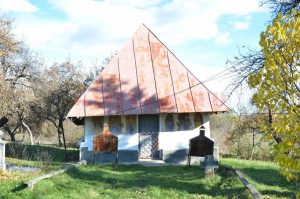

The name of the monastery indicates the fact that it was connected to the place Coșuștei, and this is the way the water which passed through a populated area, on ancient times, as it also shows the names of some villages which disappeared from this.
The oldest and its singular mention is constituted by a charter from the 10th of April 1493, from the times of Vlad Călugărul who reminds about an abbot of Coșuște which was the witness of the older properties of Vodița passed by the monastery Tismana. Therefore the three monasteries: Vodița, Crivelnic and Tismana, must be connected with the idea of defending the Romanian orthodoxy which was confronted in those past times with the Catholicism under full expansion. It is not by accident the fact that all the three monasteries as well as the Skete of Topolnța, also situated in the proximity, are connected with the name of Nicodim who is considered their founder. This means the fact that the princes from Wallachia from those times (Vladislav, Dan I and Mircea), all from the family of Basarabi, proposed to found here the monasteries resembling with the resistance bastions in the fight for defending the borders of the country. And not by mistake the one who was invested with this mission of building up was precisely the monk Nicodim, who had made his apprenticeship at Mountain Athos.
The one who clarified the problem of Crivelnic was the professor Al. Bărcăcilă who performed here archeological diggings, in the year 1936 assisted by Aurel Decei and Ioan Berciu. There were discovered ceramic remains, a grinder, metal objects, 2 silver medals and more tombs. According to the method in which the people were buried we can draw the conclusion that they were monks (they had their head place on a brick and they weren’t in the coffin). The most interesting discovery of Bărcăcilă was however the one that here we are dealing with two monasteries: Coșuștea I and Coșuștea II. The first church is built only of stone, and the second one has between the layers of stone also layers of bricks at a certain distance: the first layer of brick from place to place double marks in the interior, as well as in the exterior, the starting of the building up of the IInd church over the part kept from the Ist church. The archeologist establishes some precise connections between the two churches, outlining the importance of the first construction which had thick walls of 2 – 3 meters.
The most important discovery it is believed to have been the remaining of a Slavic inscription on a tomb stone which Al. Bărcăcilă has reconstituted: with the wish of the Father and with the help of the Son and with the accomplishment of the Holy Spirit was build up this honest and divine titular saint of the Saint … in the days of the honest – minded and loving of God Io Basarab Voivode, of the servant of God boss Hamza …. in the year 6983 (1475), this also being the inscription of the church.
The conclusion which the researcher draws is the fact that this monastery had a strategic role, illustrating the firm politic of the Romanian princes of defending the borders of the country.


